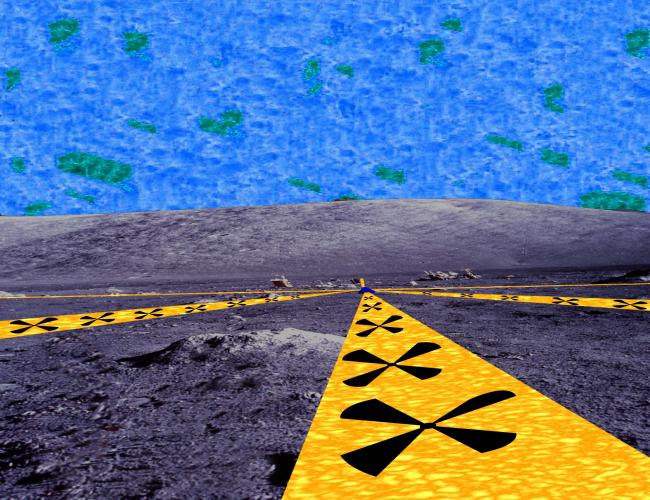Naval Research Laboratory and Smithsonian Team Up to Study Observatory for Far Side of Moon

Cambridge, MA
A team of scientists and engineers has been selected by NASA to study design concepts for a radio telescope destined for the far side of the Moon. The telescope, at present dubbed the Dark Ages Lunar Interferometer (DALI), will peer into the last unexplored epoch in the early history of the universe. The team is led by the Naval Research Laboratory (NRL) and includes key contributions from Smithsonian Astrophysical Observatory (SAO) personnel.
This release is being issued jointly with the Naval Research Laboratory.
The yearlong study is one of 19 sponsored by NASA focusing on next-generation space missions for astronomy. Collectively, these studies will contribute to the next Decadal Survey—an effort undertaken every 10 years by scientists to help establish priorities for future research directions in astronomy and astrophysics.
For this study, NASA has provided $500,000 for use in a combined effort that marries evenly the DALI team and a second, MIT-led team that independently developed a similar proposal.
DALI will study the universe as it was during the first 100 million years, when it was in its infancy and only a small fraction of its present 13.7-billion-year age. Although the night sky is filled with stars, those stars did not form immediately after the Big Bang. There was an interval that astronomers call the “Dark Ages,” in which the universe was unlit by any star. That era was dominated by an expanse of hydrogen gas, the most abundant element and the raw material for star formation. Over time, gravity caused matter to gather together and compress, forming the earliest stars and black holes.
The project leader, Dr. Joseph Lazio of NRL, pointed out that DALI will bring us closer to understanding where the universe came from and where it is going. “Probing the Dark Ages presents the opportunity to watch the young universe evolve,” he said. “Just as current cosmological studies have both fascinated and surprised us, I anticipate that DALI will lead to both increased understanding and unexpected discoveries.”
Hydrogen atoms can produce a signal in the radio part of the electromagnetic spectrum at a wavelength of 21 centimeters, far longer than what the human eye can detect. If astronomers can pick up 21-cm signals from hydrogen atoms in the Dark Ages, they can study how the first compact and luminous objects formed, and ultimately how the modern universe evolved.
Dr. Lincoln Greenhill of SAO and Harvard University explained, “As these objects formed, their ultraviolet and X-ray radiation created expanding pockets of hot, ionized gas. The universe was like an immense Swiss cheese. Over time, the growing pockets and bubbles merged, the ‘cheese’ was consumed, and from the initial darkness, our visible universe emerged.”
Because the universe is expanding, signals from distant hydrogen are stretched (or redshifted) from wavelengths of 21 cm to several meters or more. This portion of the electromagnetic spectrum is difficult for astronomers to study because it is heavily used on Earth for civil and military transmissions, all of which are millions of times stronger than the faint signal astronomers seek to detect. Additionally, the upper layers of Earth’s atmosphere, called the ionosphere, bend and distort cosmic signals as they pass through on their way to ground-based telescopes.
A partial solution is offered by locating a ground-based observatory far from human influence. SAO is a key participant in such a project, the Murchison Wide-field Array located deep in the Australian outback. (The MWA is led by the Haystack Observatory.) However, with no atmosphere and complete shielding from Earth-based signals, the far side of the Moon presents a nearly ideal environment for radio astronomers.
In this new study, scientists and engineers will investigate novel antenna constructions, automated methods to deploy antennas, electronics that can survive the harsh lunar environment, and related technology. The results will help create a roadmap for research and development needed over the next decade and lay the foundation for a future scientific mission by NASA. The NRL-led team also will build on experience it gains in developing concepts for a smaller, precursor observatory intended for the near side of the Moon, the Radio Observatory for Lunar Sortie Science.
A lunar Dark Ages telescope would be a large project, comparable to the Hubble Space Telescope but more complex and physically much larger. NRL senior astronomer Dr. Kurt Weiler commented, “We have considered Moon-based telescopes in the past, and this concept study represents an important step forward in turning this vision into reality.”
Astrophysicist Dr. Justin Kasper, DALI lead at SAO, is also the project scientist for an instrument on the Lunar Reconnaissance Orbiter (LRO) spacecraft being built by NASA to identify resources on the moon such as water and future landing sites. He commented on how the renewed focus on the Moon by the United States and other space-faring countries further builds the case for a lunar observatory.
“Launch of the LRO mission in late 2008 is the first step by the U.S. in our renewed robotic and human presence on the surface of the moon. Approval of the DALI study is a go-ahead to prepare a roadmap for Moon-based cosmology, building on LRO and other future missions.”
Scientists and engineers from institutions and NASA centers around the country are participating in the Dark Ages Lunar Interferometer study, including NASA/Goddard Space Flight Center, Caltech/Jet Propulsion Laboratory, the University of Colorado, the Smithsonian Astrophysical Observatory, the National Radio Astronomy Observatory, University of California-Los Angeles, University of California-Berkeley, the University of New Mexico, and Virginia Polytechnic Institute.
Headquartered in Cambridge, Mass., the Harvard-Smithsonian Center for Astrophysics (CfA) is a joint collaboration between the Smithsonian Astrophysical Observatory and the Harvard College Observatory. CfA scientists, organized into six research divisions, study the origin, evolution and ultimate fate of the universe.
David A. Aguilar
Director of Public Affairs
Harvard-Smithsonian Center for Astrophysics
617-495-7462
daguilar@cfa.harvard.edu
Christine PulliamPublic Affairs Specialist
Harvard-Smithsonian Center for Astrophysics
617-495-7463
cpulliam@cfa.harvard.edu